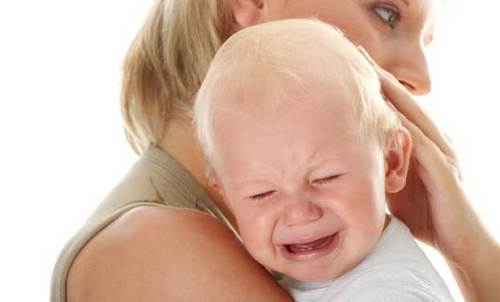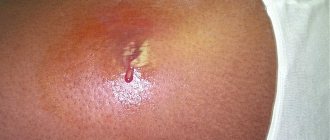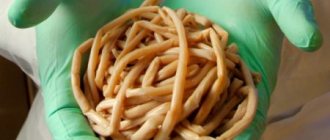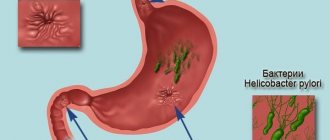Salmonellosis is a common intestinal infection, the main source of infection of which is contaminated food. The causative agent of salmonellosis is various bacteria of the genus Salmonella. In our country there are almost 500 species, the most common of which are S. typhimurium, S. Heidelberg, S. enteritidis, S. derby, S. newport, S. Anatum, S. cholerae suis, etc., the susceptibility to which varies in humans .
The minimum dose to infect a person is from 1.5 million to 1.5 billion microbial cells. Usually, after suffering from salmonellosis, a strong immunity remains, but repeated diseases occur when they are caused by other types of Salmonella bacteria.
Salmonella is very stable and can survive for a long time in the external environment:
- in reservoirs - 120 days
- in soil up to 1.5 years
- indoors in dust – up to 500 days
- in sea water - 200 days
In food:
- in milk – 20 days
- in sausage products – 2-4 months
- in kefir – 2 months
- in frozen meat – from six months to a year
- in butter – 120 days
- in beer – 2 months
- in cheeses - almost a year.
Meat and dairy products can not only preserve salmonella, but in them it successfully multiplies, while neither the appearance nor the taste of the products changes. This is the insidiousness of salmonellosis. How is this intestinal bacterium transmitted?
- One of the most common ways of becoming infected with salmonella is eggs, dairy and meat products.
- Neither smoking nor salting kills salmonella
- Freezing only helps to prolong the survival of these microorganisms in products
- Only heat treatment can destroy it; at 60 degrees salmonella dies in an hour, and at 80 degrees it kills it in 3 minutes.
- All disinfection solutions, even in normal concentrations, quickly kill salmonella microbes.
Salmonellosis - incubation period
Usually, after bacteria enter the body, the disease begins to progress within 6-72 hours . That is, for salmonellosis the incubation period lasts from several hours to three days. With timely treatment, recovery occurs in 6-10 days. Clinically, salmonellosis can manifest itself either very clearly, or symptoms of poisoning may be completely absent. Even in the absence of signs of salmonellosis, a person becomes a carrier of the bacteria, that is, he may not get sick, but be a source of infection for other people.
What are salmonella
These are gram-negative small rods with flagella, thanks to which they can move. Salmonella adapt well to external natural conditions: for example, they remain viable in manure for up to three months, in room dust for up to 80 days, and in the natural environment for months. They tolerate both low (up to -10 degrees) and high temperatures (more than 40 degrees), moisture, and can even multiply in dairy and meat products without changing the appearance or taste of the products. Susceptibility to salmonella has no age limit; Both adults and children suffer from salmonellosis, with the only difference being that in children the disease is usually more severe, and in the youngest children the highest sensitivity to it is noted.
Ways of infection with salmonellosis
After a person is infected, salmonella begins to multiply rapidly, toxins are released in the body, the action of which leads to disruption of the nervous system and loss of fluid through the intestines. Therefore, an infected person experiences severe intoxication, which is expressed by: diarrhea, fever, weakness, vomiting, headache. There are several ways of becoming infected with salmonellosis:
Infection through food
Infection with salmonellosis is possible through almost all food products. For a disease to occur, a massive infection must occur, and the causative agent of salmonellosis multiplies better and faster in protein foods. Moreover, the share of meat products among all cases of infection is about 70 percent. Then come dairy products, fish and egg products. Plant foods do not often cause disease, since bacterial growth practically does not occur in them. During heat treatment, the number of salmonella is sharply reduced, so eating hot or warm foods is absolutely safe. Even if a small amount of bacteria still remains, it is not enough to cause salmonellosis to develop. During long-term storage, the amount of the salmonellosis pathogen increases and, accordingly, the risk of salmonellosis infection also increases.
Infection with salmonellosis through household contact
What to do if a family member or close friend is affected by salmonellosis? How is the infection transmitted from person to person? Infection with salmonellosis through contact with a patient occurs in the same way as with other intestinal infections. A carrier can only shed salmonella through feces.
Therefore, salmonellosis is transmitted from person to person very rarely; it only happens through contact, if the rules of personal hygiene are not followed, simply through dirty hands. In addition, massive damage in this case is unlikely, and only particularly susceptible people get sick. Particularly susceptible to infection are people weakened by other diseases, young children, and the elderly, for whom the salmonellosis pathogen is dangerous even in small quantities. Contact-household infections usually occur in hospitals in premature and weakened children.
Infection through water
If feces of infected people and excrement of sick animals get into water, water contamination with salmonellosis is possible. But the reproduction and accumulation of the pathogen does not occur in the aquatic environment, and accordingly the number of bacteria in the water is small. Such routes of infection with salmonellosis are very rare.
Airborne
Intestinal infections, including salmonellosis, are not transmitted by airborne droplets.
By airborne dust
It is believed that when spraying the excrement of pigeons living on the roofs of buildings, salmonella may enter the premises. In hospital rooms with small children, salmonella is sometimes found in the air. This is possible in cases where there are ventilation problems in the premises.
Salmonellosis in children is no different in the nature of its manifestations from what is observed in the adult world. In children under one year of age, the septic form often develops. Differences arise during the treatment phase. We will talk mainly about salmonellosis, and to a lesser extent about children. The disease is caused by bacteria from numerous serotypes. The observed picture is remarkably similar. This is an acute intestinal infection - poisoning.
Salmonella persists in the environment - it lies for years in dried excrement. That’s why mothers tell us not to pick up any nasty things from the floor. Nature has endowed the bacilli with slight virulence. For a disease to occur, at least 100 thousand units must penetrate into the body. In the case of dysentery and typhoid, much more modest amounts are indicated. Throughout the existence of mankind, immunity to small doses of the causative agent of an infectious disease has developed.
Risks of pathology
The consequences of salmonellosis in children can be serious if treatment is started late or the child has a very weak immune system.
Important! A timely visit to the doctor will help to avoid dangerous complications of the disease.
If the body has been dehydrated for a long time, then there is a high probability of developing kidney failure. As a result, nitrogenous waste accumulates in the patient's blood. Bacterial excretion lasting more than 3 months indicates that the disease has acquired chronic status.
Intoxication does not have the best effect on the functioning of the cardiovascular system. An advanced disease can result in cerebral edema. Salmonellosis is dangerous due to such consequences as inflammatory processes that affect a variety of internal organs. This is explained by the rapid spread of salmonella, which is carried throughout the body by the blood.
Diarrhea with a strong unpleasant odor is one of the characteristic signs of pathology
Patients who have a chronic form of salmonellosis may experience relapses that provoke immunodeficiency. Salmonellosis occurs more often in children under one year of age, so you need to pay special attention to the child’s behavior in order to promptly notice changes and seek advice from a doctor.
The causative agent of the disease
Russian scientists have worked hard - they have compiled a list of names of bacteria that are more often found in the Russian Federation and cause salmonellosis in a child. The bacilli belong to the genus Salmonella, from which the specific name of the disease comes. Based on the structural characteristics of DNA, doctors distinguish 2 types.
Pathogens are limited to a small number of serovars that are rarely encountered in practice. The number of serotypes is large - more than 2500. 10-15 are of practical importance for doctors. These species account for 90% of cases. The optimal environment for reproduction is moderately alkaline (pH from 7.2 to 7.4), observed in the duodenum, at a temperature of 37 degrees Celsius.
Classification
ICD-10 pays a lot of attention to salmonella. The disease is classified according to section A02, which includes 4 subgroups:
- 1 - septicemia.
- 2 - local infection.
- 8 - other specified infections.
- 9 - unspecified infection.
The classification of salmonellosis according to clinical signs has not been accepted. The disease occurs cyclically with characteristic biochemical and bacteriological signs in feces. Options for the development of events in an atypical picture:
- The erased form occurs without pronounced symptoms. Registered cases mainly occur in epidemic areas. In other cases, people do not think to see a doctor.
- The asymptomatic form is established by taking tests. If the human body is accustomed to small doses of pathogens, it reacts less violently. Fixed in regions where salmonella is common. According to the normal pattern, the antibody titer in the blood increases and decreases. This is the primary sign for diagnosis.
- Carriage is observed in persons who have had salmonellosis. It is considered chronic when the process lasts more than three months. Another type of carriage is transient. Pathogenic microflora passes through the intestines without causing harm. The bacterium remains dangerous to others.
According to the severity of the course, three forms are distinguished: mild, moderate, severe. They differ in flow patterns - according to the type of gastritis, enteritis, colitis. The nature of the course is smooth, non-smooth (with exacerbations and relapses). Conditional division by time:
- Up to 1 month – acute.
- Up to 3 months – protracted.
- Over 3 months – chronic salmonellosis.
Infection scheme
The rods are small in length (a few microns), equipped with half a dozen pairs of flagella for propulsion. This helps the bacillus to carry out invasions:
- Adhesion - moving the flagella, the rods go deeper into the mucus and attach to the epithelium. The local immune system in the initial period is completely defenseless.
- Invasion - the path of movement in the small intestine resembles typhus. Bacteria penetrate M cells and infect lymphatic tissues.
- Spread - bacilli survive inside phagocytes and multiply there. This leads to the spread of the disease throughout the body to a generalized form. Normally, blood is sterile and infection does not occur.
The power of the wand is endotoxin, which stimulates the body to non-standard reactions. This is manifested by fever and the synthesis of cytokines unnecessary for the body. In some places it reaches the point of blood clotting in the vessels. Diarrhea is caused by a cytotoxin. The production of chlorine ions is disrupted, sodium is not bound by anything. This causes water to leak into the intestines.
After an illness, unstable immunity is developed for 3-6 months. An intestinal infection is forgotten by the body. Relapse is possible.
Pathogenesis of salmonellosis
The development of the infectious process largely depends on the mechanism of infection (food, contact, etc.). the magnitude of the infectious dose and the degree of pathogenicity of the pathogen, the immune defense of the macroorganism, age, etc. In some cases, intestinal infection occurs rapidly, with the development of endotoxin shock. severe toxicosis with exicosis or a generalized infectious process (septic forms) and with significant bacteremia (typhoid-like forms), and in others, erased, subclinical forms or bacterial carriage occur. Regardless of the form of the disease, the main pathological process develops in the gastrointestinal tract and mainly in the small intestine.
The big picture
Children's salmonellosis is severe and long-lasting. Due to the weakness of the immune system, intoxication is pronounced, and epithelial lesions are deep. From time to time, bacteremia develops (bacillus in the blood), reaching toxic-dystrophic, septic forms. In newborns and infants it goes away when the child reaches three years of age. A relatively mild course dominates here, up to the development of carriage (without symptoms).
There is no incubation period. The first signs of salmonellosis in children are observed within a few hours after contact with the infection. The gastrointestinal form manifests itself more often in children - up to 98% of cases. Other – falls on a more dangerous generalized course with general poisoning of the body. In 80% of cases there will be signs of acute intestinal poisoning. In the subacute version, 1-2 signs are recorded (colic and intoxication), and after a couple of days symptoms of dyspepsia appear. Intoxication provokes the manifestation of a number of nonspecific symptoms:
- Fever.
- Sweat.
- Chills.
- Prostration.
- Physical inactivity.
- Decreased appetite.
Dyspepsia covers a spectrum of symptoms related to the gastrointestinal tract. In two thirds of cases the liver becomes enlarged. The disease is often accompanied by mucosal inflammation syndromes - gastritis, enteritis, enterocolitis, hemocolitis. The disease lasts from several days to weeks. Clinical signs are not used for classification and diagnosis.
Individuals with a deficient immune system suffer greatly for obvious reasons.
Descriptive picture by severity
There is no classification based on clinical signs. Doctors have long noticed the key points. The severity is determined by changes in the blood and signs present in the stool.
Light
This share of cases in epidemics accounts for up to 40% of those registered. The disease begins with a fever with a temperature of up to 38 degrees Celsius. Intoxication is mild, there is mild pain in the absence of palpation. The stool is loose and infrequent (up to 5 times a day).
Complications and syndromes
Treatment of salmonellosis in children is aimed at rehydrating the body - replenishing moisture loss. Due to the frequent urge to defecate and vomit, fluid reserves in the body are sharply reduced. More often, the syndrome is observed when the disease progresses along the path of enteritis or gastroenteritis.
In two thirds of cases the liver is greatly enlarged. It appears by the end of the first week and persists for a long time. Some of them will have an enlarged spleen. The diagnosis cannot be made by external signs - these organs are the first to take the blow of infections.
Doctors name a wide range of conditions:
- Kidney failure.
- Perforation of the intestinal wall.
- Neurotoxicosis.
- Rectal prolapse.
- Sepsis.
- Hypovolemic shock.
Treatment of children
Diagnostics mainly consists of collecting information. At the first stage, treatment is carried out in the usual way. In case of local form, antibiotics are not taken; antiseptics may be effective. Diagnostics in pediatrics focuses on:
- The presence of dangerous allergic reactions to drugs in the infant.
- State of the child's psyche.
- Threat to life due to third party causes.
This imposes adjustments when treatment is prescribed. Differential diagnosis with other diseases is carried out. Typical clinical signs:
- Severe fever of moderate duration.
- Intoxication of the nervous system: lethargy, loss of strength, loss of appetite up to its complete absence.
- Invasive, watery, mixed diarrhea.
- Weight loss. Thirst, dry mucous membranes and skin.
- The large fontanel and eyeballs are examined.
The degree of severity is assessed based on the following criteria:
- Severity of dehydration.
- The degree of damage to the gastrointestinal tract.
- Dysfunction of certain organs.
- The severity of symptoms characteristic of intestinal infections.
- Sepsis.
- The presence of infectious-toxic shock.
Today, salmonellosis can be cured at home (unlike typhus or dysentery). If the measures taken are ineffective (within 2 days), hospitalization is carried out. Signs for hospitalization according to the guidelines of the World Gastroenterological Organization:
- Mental changes.
- Ineffectiveness of oral rehydration.
- Prematurity.
- Chronic diseases.
- Age up to six months.
- Weight up to 8 kg.
- Severe fever in newborns - above 38 degrees Celsius, up to three years - above 39.
- Presence of blood in the stool.
- Severe diarrhea, vomiting.
Attention is paid to residential factors. Prevention of the spread of the disease requires hospitalization of a child from a large family or shelter.
During hospitalization, they treat dehydration, collect toxins with sorbents, suppress the growth of the strain with antimicrobial drugs and by stimulating the immune system. At the same time, they fight fever and abdominal pain (by taking antispasmodics). When the symptoms subside, the salmonella carrier undergoes procedures to restore the intestinal microflora.
The criteria for recovery are the absence of elevated body temperature for more than 2 days, normal stools, no enlargement of the spleen or liver, and disappearance of inflammation.
Salmonella group D.

Causative agents of food toxic infections (Salmonella enteritidis group D) are also salmonella group D. - in water - 120 days;
— in meat and sausages – up to 100 days;
- in soil - 500 days.
In meat, dairy products and eggs, these bacteria can actively multiply without changing their appearance.
The causative agent of foodborne salmonellosis is Salmonella enteritidis group D. It is classified as a causative agent of specific toxicomas.
The main sources of human infection are:
- up to 50% of all cases - poultry (especially chickens and waterfowl) and eggs (salmonella can not only infect the shell, but also penetrate inside); Salmonella at a temperature of +5° are able to maintain their vital activity: - in eggs for up to 13 months, - in egg powder for up to 9 months;
I would like to draw your attention to the following points:
— currently S.enterocolitica group D dominates in its prevalence over other species of Salmonella, including S.typhimurium group B;
- which of these salmonellas is associated with infection of eggs, and which one with infection of chicken meat can be found in the collection
- up to 20% of all cases - beef and pork; salmonella live in frozen meat for 6–13 months;
- up to 5% of all cases - shellfish, turtles and fish, where salmonella live for 10 - 30 days at a temperature of +5°;
- up to 15% of all cases - meat sausages, where salmonella live for 60 - 130 days, at a temperature of +5°;
- up to 10% of all cases - vegetables and fruits; in frozen vegetables and fruits, salmonella live from 0.5 to 2.5 months.
In order to be poisoned by foodborne salmonellosis, you must eat a product that contains 1,000,000 salmonella bacteria in 1 gram.
When foodborne salmonellosis occurs:
- short incubation period from 2 to 6 hours, on average - 7 - 24 hours;
- acute onset of the disease with symptoms of intoxication, namely: increased body temperature to 38 - 39 degrees, chills, repeated repeated vomiting of eaten food;
- rapid development of the disease itself in the form of copious watery stools mixed with mucus (may be without pathological impurities or green color), stool frequency does not exceed 10 - 15 times, abdominal pain. In mild cases, poisoning can result only in vomiting without diarrhea;
- rapid release of the body from the pathogen;
- absence of subsequent contact infections (if you get sick yourself, you will not infect your family members, unless, of course, they themselves consumed the contaminated product).
If foodborne salmonellosis is suspected, the following are taken for bacteriological examination:
- initial products and semi-finished products that were used for its preparation;
- daily samples of prepared food, if it was stored in the refrigerator, this is when registering food-borne salmonellosis in hospitals or child care institutions;
- vomit, washing water, feces and urine of the victim;
— blood of patients for serological reactions;
Rehabilitation
A diet is prescribed for the period of treatment. Children over one year of age are prescribed unadapted fermented milk products. When a child is ill, rehabilitation is carried out.
- Activities are carried out in a smooth sequence, forming a single complex.
- The duration of the procedures ends at the stage of early convalescence.
- Adequacy of measures taking into account physical condition and age.
- Monitoring the effectiveness of ongoing activities.
After discharge, observation by a doctor is carried out according to the recommendations given in the hospital. The general condition is assessed. The study (in the absence of specialized specialists) is carried out by a pediatrician or therapist.
In the event of an outbreak of intestinal infection in a children's group, it cannot be said that the child is healthy, even in the complete absence of symptoms. An incubation period for salmonellosis is possible. There are cases where signs of the disease appeared only a week after infection.
Methods of infection
The causative agents of the infection are bacteria from the genus Salmonella (S. Typhimurium, S. Enteritidis). Most often, infection occurs through food.
Salmonella is resistant to adverse environmental factors and can survive in soil and natural water bodies for a long time.
Main routes of infection:
- Bacteria enter the body by eating contaminated food. The most dangerous thing is insufficient cooking (raw eggs, rare steaks). Protein-rich foods are the best breeding ground for salmonella. Food contamination occurs due to improper storage and non-compliance with personal hygiene rules.
- Often a person becomes infected from sick people or healthy carriers of the infection. Routes of transmission by contact: through dirty hands or contaminated household items. Pathogens are excreted in feces. Domestic animals (pigs, poultry, cattle) can be carriers of salmonellosis.
- Transmission of infection through contaminated water, swimming in natural bodies of water or drinking is possible.
Pathogenesis of the disease
Thus, the pathogenicity factors of salmonellosis are:
- adhesion (the ability to reproduce in the human body),
- invasiveness (the ability of Salmonella to invade epithelial cells without destroying the cell membrane), which ultimately contributes to the generalization of the infectious process,
- toxigenicity (salmonella release a toxin).

Incubation period of salmonellosis
People of any age and gender are susceptible to intestinal infections. The incubation period for salmonellosis ranges from several hours to 7 days. The duration depends on the state of immunity and the method of infection.
In adulthood
The incubation period for salmonellosis in adults ranges from 1-2 hours to 7 days. In patients weakened after a serious illness or chemotherapy, the first symptoms appear within a few hours. In case of massive infection (foodborne infection), the incubation period is 12-24 hours.
A significant number of bacteria die in the stomach under the influence of enzyme systems and an acidic environment. This produces a large amount of toxins that are absorbed into the blood. Symptoms such as fever, vomiting, and abdominal pain appear.
Therefore, the incubation period depends on the number of salmonella that have entered the body. With contact route of infection, clinical manifestations of intestinal infection appear later (after 4-5 days).
Salmonellosis in babies (children)
The incubation period for salmonellosis in children is shorter than in adults. The interval between infection and the appearance of the first symptoms of the disease ranges from 1-2 hours to 4 days.
Salmonellosis in children is more severe, which is associated with physiological characteristics: weak immunity, low acidity of gastric juice.
A larger number of bacteria survive in the child’s digestive system, which begin to actively multiply and quickly colonize the intestines.
What problems can a baby have?
Symptoms of salmonellosis in an infant appear within 1-2 hours. The younger the child, the earlier the disease begins.
In a newborn baby, symptoms from the gastrointestinal tract appear late, so it is difficult to determine the duration of the incubation period.
The child becomes lethargic, spits up, and stops gaining weight. In premature babies, salmonellosis often takes a generalized form, affecting the lungs, liver and kidneys. An unclear clinical picture is a common reason for late diagnosis.
Pets
Salmonellosis most often develops in animals (piglets, lambs, calves) in the first months of life, which is explained by an immature immune system. As a rule, it is difficult to determine how many days the incubation period lasted.
Most often, the first signs of the disease appear after 1-7 days. The younger the animal, the sooner the condition worsens.
Salmonellosis enteritidis in children
In second place among intestinal infections is salmonellosis in terms of the number of diseases. Schoolchildren are more susceptible to the disease, and its main source is pets. A person becomes infected either through contact with them or by eating animal products.
Salmonellosis in children
Acute salmonellosis infection is accompanied by severe dehydration (dehydration) and intoxication. In infants it can occur with septicemia, and in older ones it can occur as typhus. The disease usually develops in the form of outbreaks or isolated cases. More often, salmonellosis in children is registered in the summer, since in the heat the storage conditions of food products are violated.
The source of salmonella infection is often animals or food. Germs can also be transmitted through people. An infant can become infected from the mother in utero or through household contact. Premature and newborn babies who have weak immunity are at risk. The main routes of transmission of salmonella enteritidis:
- Food. Infection occurs after eating meat, fish, milk, and chicken eggs, which are consumed without heat treatment.
- Contact and household. When they become infected through the dirty hands of parents or medical personnel, changing tables and other care items. Dangerous salmonella germs are often found on toys or pacifiers.
- Transplacental. Infection is transmitted from a pregnant mother in utero.
- Airborne dust. The cause of infection is the entry of microbes into the body through inhalation of dust in kindergartens, clinics and other public places.
Incubation period of salmonellosis in children
Any infection begins with incubation. This is the period of time when a person has become infected, but symptoms of the disease have not yet appeared. The incubation period of salmonellosis in children lasts differently. The average duration is 8-72 hours.
During an outbreak of infection, the first symptoms may appear no earlier than 7-8 days. Salmonella in infants lasts 3-4 days. It is important for young mothers not to overlook the first symptoms.
The baby refuses to eat, sleeps poorly, has frequent diarrhea (up to 10 times a day), and tearfulness increases.
Signs of salmonellosis in children
How does salmonellosis manifest in a child? The onset of the disease is accompanied by colitis syndrome. After the incubation period, there is an increase in temperature, sometimes up to 40 degrees, and the state of health sharply worsens. Signs of salmonellosis in children are very diverse.
The disease can occur with symptoms of gastroenterocolitis, enteritis, gastroenteritis, gastritis. The severity of the course and clinical manifestations of the infection depend on the route by which the pathogen entered the body, the age of the small patient, and the state of his immunity.
Typical symptoms of salmonellosis:
- nausea, vomiting, dehydration;
- stomach ache;
- loss of appetite;
- stool with salmonellosis is liquid with impurities;
- enlarged spleen and/or liver.
Diagnosis of salmonellosis in children
At the first sign of infection, the child should be seen by a doctor. Diagnosis of salmonellosis in children begins with serological and bacteriological examination.
The following samples are taken for analysis: blood, urine, gastric lavage, vomit, feces. Serological diagnostic methods are designed to identify specific antibodies and antigens in biological material.
To detect them, RCA (coagglutination reaction) and ELISA (enzyme-linked immunosorbent assay) are used, which determine the antibody titer in the blood.
Treatment of salmonellosis in children
At home, treatment of salmonellosis in children should be comprehensive. These are symptomatic, pathogenetic, etiotropic therapy, diet and bed rest.
Hospitalization is carried out according to clinical indicators, and depends on the severity of the disease. Patients with signs of food intoxication are required to be admitted to the hospital, regardless of age.
Bed rest is indicated for mild cases of the disease - 1 week, for severe cases - up to 3 weeks.
Salmonella enterica
(or
intestinal salmonella
, lat.
Salmonella enterica
) is a type of bacteria from the genus Salmonella.
Common abbreviation for S. enterica
. All Salmonella pathogenic to humans belong to this species.
Salmonella in the taxonomy of bacteria
Species salmonella enterica
into the genus Salmonella (lat.
Salmonella
), family enterobacteria (lat.
Enterobacteriaceae
), order enterobacteria (lat.
Enterobacteriales
), class gamma-proteobacteria (lat.
γ proteobacteria
), phylum proteobacteria (lat.
Proteobacteria
), kingdom Bacteria.
Many serotypes of Salmonella enterica
- pathogens of human diseases, including typhoid fever, paratyphoid fever, salmonellosis.
Salmonella species Salmonella bongori
are not pathogenic to humans.
The species Salmonella enterica
includes 7 subspecies (each of which has many serotypes):
- (I) enterica
- (II) salamae
- (IIIa) arizonae
- (IIIb) diarizonae
- (IV) houtenae
- (VI) indica
- VII
Source: https://ParazitHelp.ru/parazity/salmonellez-jenteritidis-u-detej.html
Symptoms of salmonellosis
Clinical symptoms of intestinal damage are similar to food poisoning, which leads to untimely treatment. In cases of infection in a children's group, careful monitoring of the child is necessary throughout the entire period of symptoms (7 days). Even a slight deterioration in health is a reason to consult a doctor.
Typical signs of salmonellosis:
- severe, wave-like increasing abdominal pain;
- profuse vomiting;
- fever;
- severe weakness, decreased blood pressure;
- frequent watery stools with foam and discoloration of stool (greenish or orange);
- painful urge to defecate during complete bowel movement;
- dehydration (dry skin, decreased diuresis);
- pain in muscles and joints.
During pregnancy, signs of salmonellosis are often mistaken for manifestations of toxicosis, which leads to a late start of therapy. Consequences of the error: development of severe dehydration, transition of infection to septic form. Lack of qualified medical care is dangerous for the life of mother and child.
To diagnose the disease, a bacteriological analysis of stool is done. During the incubation period, antibodies to Salmonella can be detected using an indirect hemagglutination reaction. In a general blood test, the number of leukocytes and eosinophils increases.
Diagnosis of the disease
If you suspect that salmonellosis has developed in a child 2 years of age or younger, you should seek advice from a specialist who can confirm or refute the diagnosis. The doctor has many methods used during examination in his arsenal:
- inspection;
- bacterial sowing;
- stool is tested for dysbacteriosis;
- UAC;
- a blood test to determine the presence of antibodies to salmonella.

Only after a full examination and receipt of test results, parents who have no idea how salmonellosis is treated in children will receive detailed advice regarding the specifics of therapy.
Treatment methods for salmonellosis
Treatment tactics are selected based on the patient’s condition and the severity of dehydration symptoms. For mild intestinal infections, treatment at home is possible. Young children are sent to an infectious diseases hospital.
- Medical nutrition. Fermented milk products, baked goods, and sauerkraut are excluded from the diet.
- Elimination of dehydration: drinking saline solutions, infusion therapy.
- Prescription of sorbents and enzyme preparations.
- Fighting infection: antibacterial therapy, Salmonella bacteriophages.
For severe spasmodic pain in the abdomen, antispasmodics are used. To restore normal intestinal microflora, it is recommended to drink Linex. Treatment for salmonellosis is long-term; complete recovery requires 21 days.
Dietary recommendations

In case of salmonellosis, baby food should be gentle, protecting the intestinal mucosa from strong mechanical and chemical effects. The following should be completely excluded from the diet:
- whole milk;
- vegetables with coarse fiber;
- animal fats;
- marinades, spices, smoked meats, seasonings.
The following will be useful for a child affected by salmonella:
- cottage cheese;
- low-fat cheese;
- boiled fish;
- fruit jelly;
- steam cutlets and meatballs;
- oat and rice porridges with water and vegetable broths.
Complications and methods of prevention
Once in the body, bacteria multiply in the intestines, causing inflammation of the mucous membrane and disrupting the digestion process. Excessive repeated vomiting and diarrhea lead to loss of fluid and mineral salts. Rapid dehydration occurs in infants.
- the appearance of seizures;
- dehydration;
- renal failure;
- generalization of infection;
- chronic carriage of salmonella (isolation of the pathogen for more than 3 months).
After an intestinal infection, digestive disorders and nutrient absorption disorders are possible. Enzyme preparations are used to correct the condition. Proper treatment helps to quickly cope with salmonellosis and prevent the development of complications.
Prevention methods
To prevent the spread of infections in the body, it is necessary to regularly test for salmonellosis people employed in the food industry, workers in medical and child care institutions. If bacteria are detected, the employee is suspended from work until completely cured.
Preventing the spread of infection:
- strict sanitary control at slaughterhouses;
- regular testing of finished products for salmonellosis;
- epidemic-safe cooking (heat treatment of hazardous products, use of a separate cutting board for raw fish and meat).
In case of registration of salmonellosis, quarantine is not imposed. If there is a high risk of infection, medical observation is required for 7 days (the period corresponding to the maximum incubation period). Regular thermometry and stool monitoring help to detect the disease on time. Bacteriophage is used for emergency prevention of salmonellosis.
Epidemiology of salmonellosis
Salmonellosis is widespread throughout the world and throughout our country. In terms of incidence among intestinal infections of established etiology, salmonellosis ranks second after shigellosis. Mostly children of preschool age are affected (65%). the leading pathogen is Salmonella enteritidis.
The main source of infection is domestic animals: cows, sheep, pigs. dogs, cats, birds, etc. The disease in animals can occur in a pronounced form or be erased, but more often there is asymptomatic carriage of Salmonella. Human infection can occur either through direct contact with a sick animal or through consumption of animal products (milk, meat, cottage cheese, sour cream, eggs, etc.).










